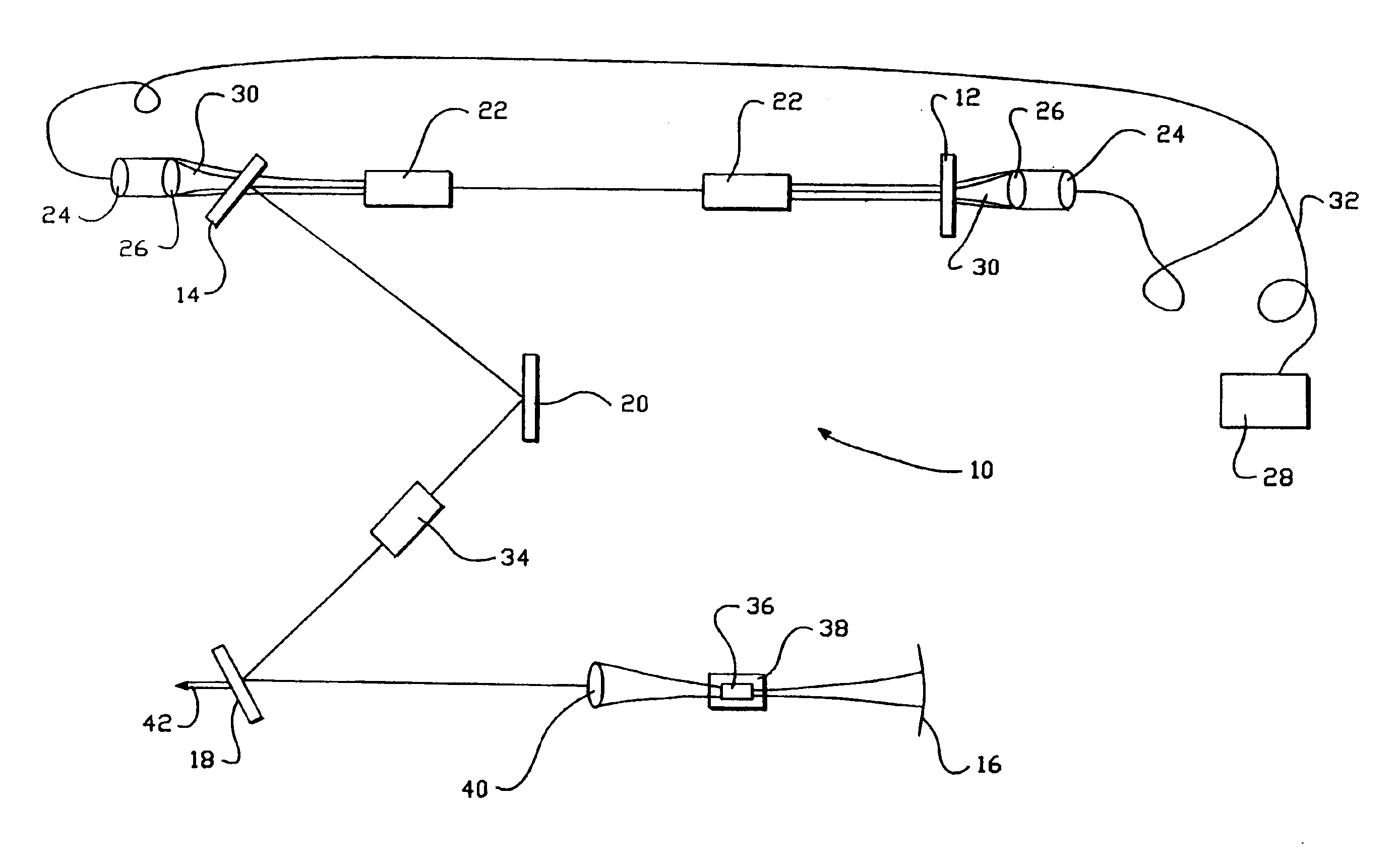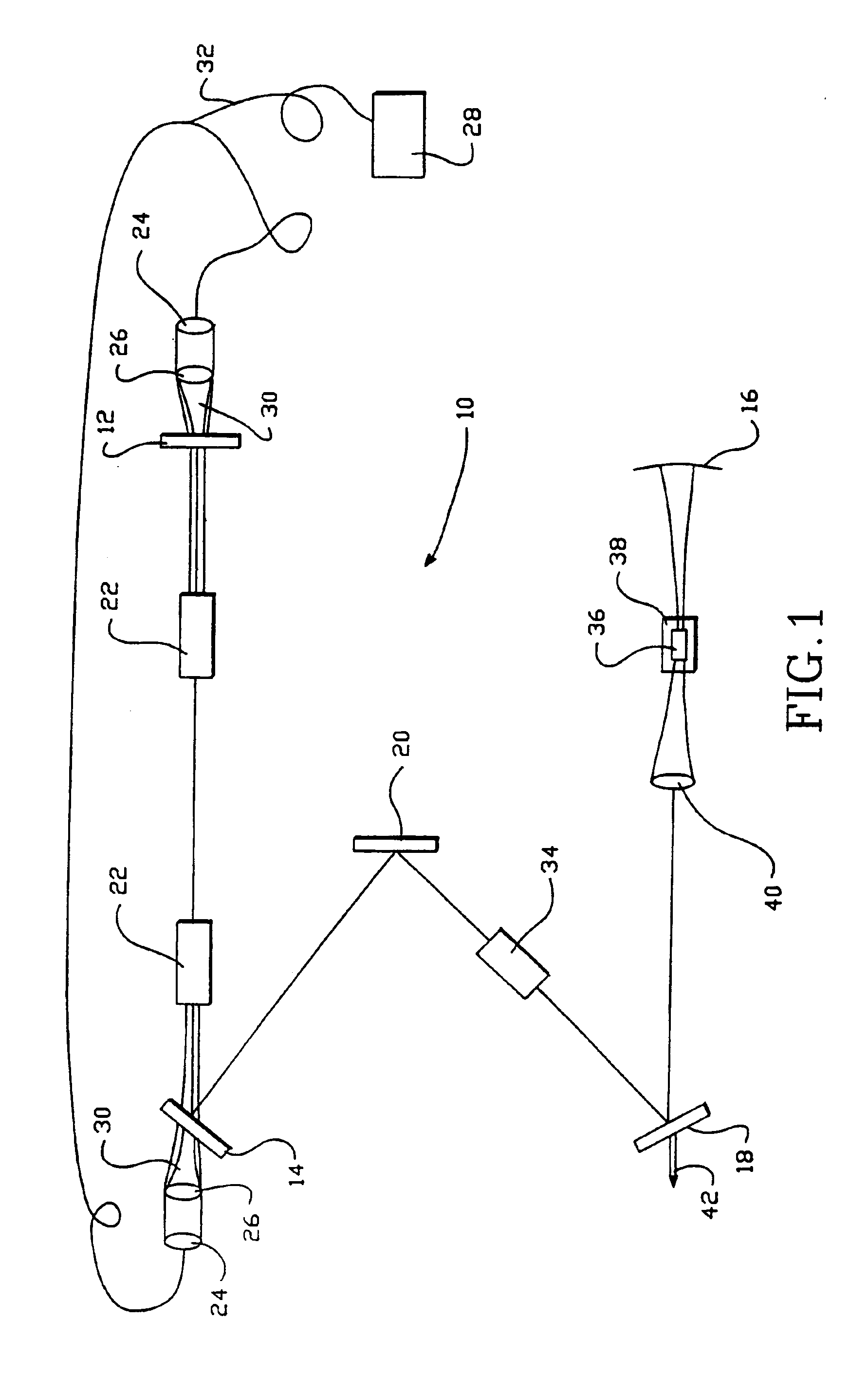[0013]It is an object of the invention to provide a continuous-wave (CW), diode-pumped, multiaxial mode, intracavity-frequency-doubled
solid-state laser with
high amplitude stability.
[0021]Yet another object of the invention is to provide a CW, diode-pumped, multiaxial mode, intracavity-frequency-doubled laser and intracavity-frequency-tripled laser with high amplitude stability that produces a blue or
ultraviolet output.
[0027]With the present invention, a large number of axial modes oscillate, with as few as on the order of 10 and as many as about 200, preferably about 100. With this configuration, the
relative power in each
axial mode is smaller than in the case of 2 to 4 axial modes. The
relative magnitude of the
nonlinear coupling of the axial modes is therefore reduced. However, the statistical probability of
coupling of one mode to some other mode via
sum frequency generation is increased, since the number of modes is increased. With the present invention, none of the characteristic spiking behavior, as observed by Baer in his early work, is observed for any of the individual axial modes of the large number that are oscillating. This indicates that with the present invention no one
axial mode is able to reach a
high peak power and induce a high nonlinear loss for the other axial modes. Thus, the present invention provides the oscillation of a large number of axial modes and results in a highly amplitude stable output beam.
[0031]In a high power Nd:YVO4 embodiment, approximately 26 W of total pump power is used to excite the laser crystal, with ˜13 W incident upon each end of the crystal. Multiple laser crystals can also be used. An LBO crystal is used for frequency doubling the intracavity
infrared beam that is emitted by the laser crystal or crystals. The output power is typically on the order of 6 W of green in a TEM00 mode, which corresponds to an
optical efficiency (Pout / Pincident) of approximately 23%. Including a
fiber bundle
transfer efficiency of 85%, and a diode-electrical-power-to-optical-power-efficiency of 40%, the electrical-diode-power-to-optical-output-power-efficiency of the intracavity frequency doubled laser is on the order of up to 16%. If TEM00 is not required, or if very
low noise is not required, up to 8 W of 532 nm output can be obtained for the same 26 W of pump power, representing even higher efficiency. An aperture is typically required for TEM00 operation. When optimized for
low noise, i.e., high amplitude stability, the RMS
noise can be lower than 0.5% for a 6 W frequency-doubled output. Typically, the output beam is substantially TEM00 in this case. If care is taken to eliminate acoustic
noise associated with vibration or
water cooling, RMS noise on the order of 0.2%, or less, is achieved. The highly amplitude stable output of these lasers is relatively insensitive to environmental parameters, such as temperature.
[0032]In these embodiments of this invention, the green or doubled output beam is substantially round since Type I,
non critical phase matching (NCPM) is employed, which provides a large acceptance angle and minimizes walk-off, as will be recognized by those of ordinary skill in the art. This is very helpful when a “
double pass geometry” is employed. If a nonlinear crystal with nonzero walkoff is used, like KTP, the
double pass geometry can result in an imperfect overlap between the two doubled beams; one beam is generated upon the
first pass, the second on the second pass. The nonlinear crystal
lithium triborate, LBO, is used. The
phase matching and doubling efficiency are optimized by optimizing the crystal temperature in the vicinity of 145 to 175° C., with ˜155° C. being typical for conversion of 1064 nm to a 532 nm
harmonic. In certain embodiments, the green beam and
infrared beam are nearly
diffraction limited, and the
RF noise spectrum shows no
heterodyne peaks other than the primary c / 2L peak at about 140 MHz. This indicates that the laser oscillates on its lowest order spatial mode. The RMS noise from 10 Hz to 10 MHz can be lower than 0.5%, and even 0.1% or less, although even a noise lower than 3% RMS can be useful. An aperture is typically used to insure TEM00 operation with high amplitude stability in the Nd:YVO4 embodiment.
[0033]The nonlinear crystal KTP can be used for intracavity doubling in conjunction with the multiaxial mode techniques of the present invention. Care is taken to insure phase-matching and appropriate polarization rotation as identified by Nightingale et al. and Wiechmann et al. The combination of these techniques with the multiaxial mode doubling of the present invention achieves a robust,
low noise, doubled output beam. In one embodiment, using Nd:YVO4 pumped by 26 W of diode pump power from two
fiber-coupled diode bars and a resonator configuration similar to that used with LBO, approximately 5 W of TEM00 output at 532 nm is generated with approximately 0.5% RMS noise. The orientation, angle, and temperature of the KTP crystal must be optimized for a Type II intracavity interaction that preserves the polarization of the eigenmode upon one round trip of the cavity.
 Login to View More
Login to View More  Login to View More
Login to View More 


